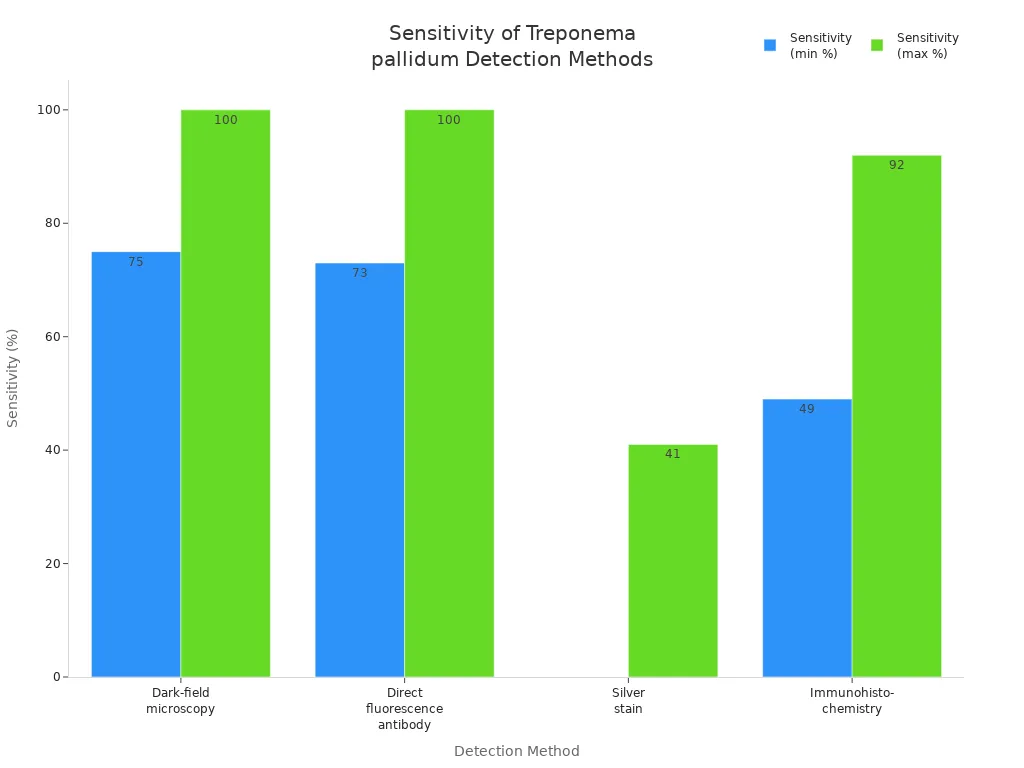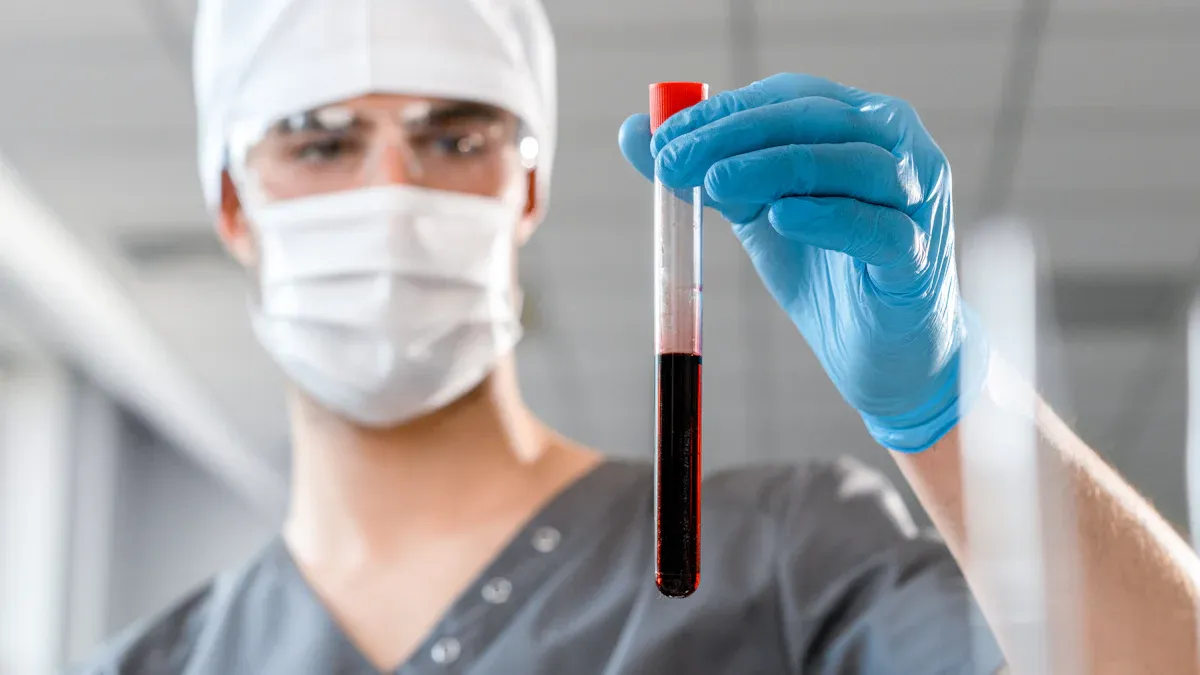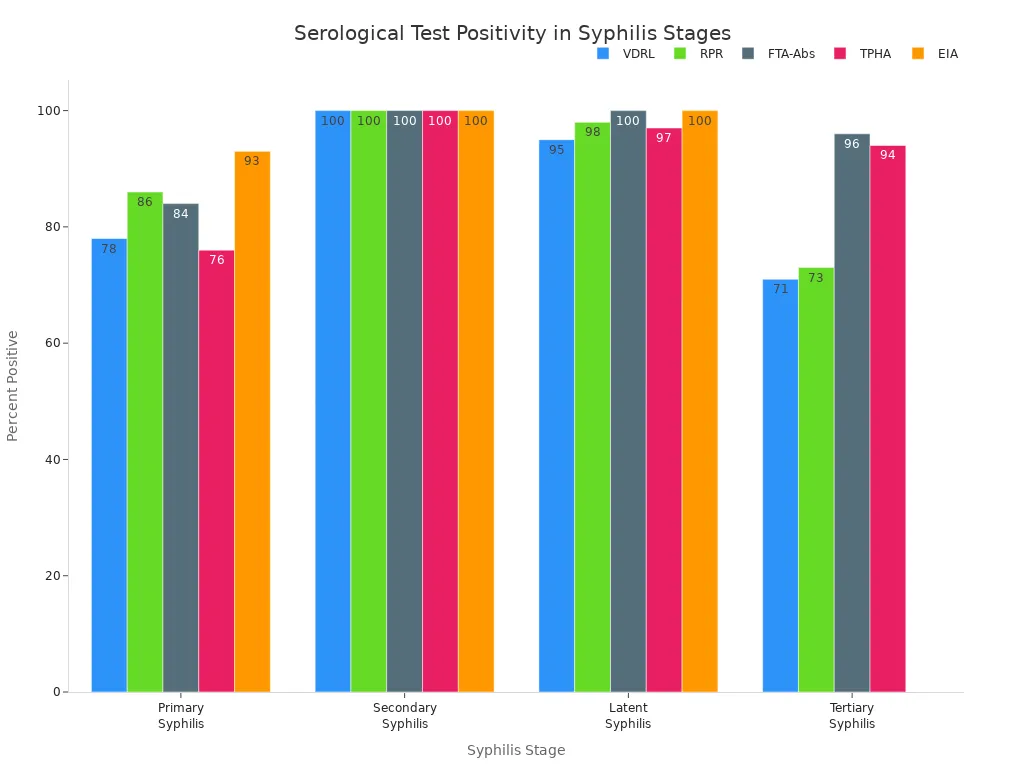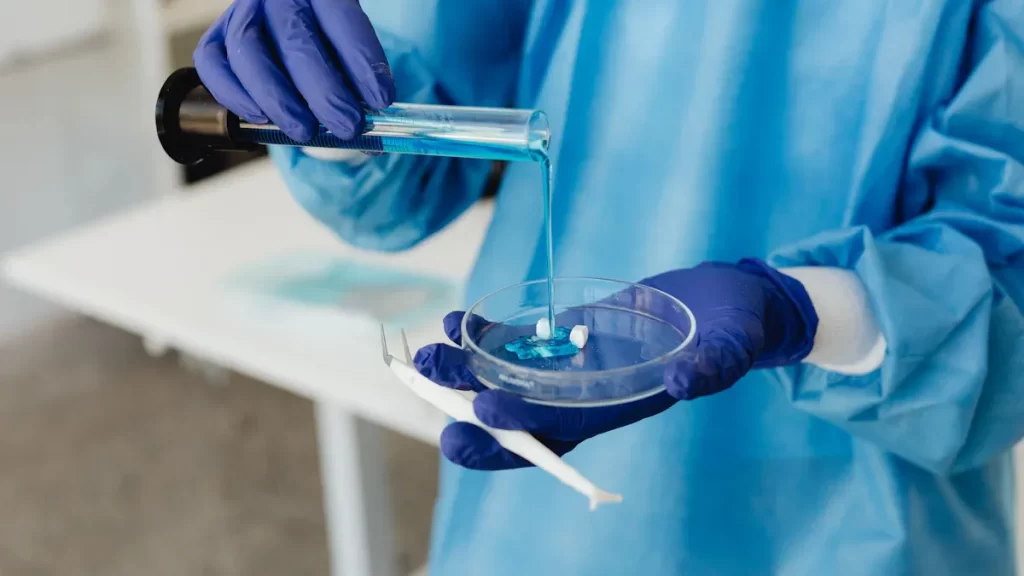News & Events
Modern Approaches to Detecting Treponema Pallidum Antibodies in 2025

You now have access to advanced methods for treponema pallidum antibody detection, which help you achieve a more reliable syphilis diagnosis. Accurate results matter because early detection prevents complications. Recent progress has made testing faster and more precise:
- Reverse algorithms now use sensitive treponemal tests first, so you get fewer false negatives.
- Rapid diagnostic tests offer quick results in many settings.
- Automated systems, such as the BioPlex 2200 Syphilis system, boost efficiency for labs and clinics.
Key Takeaways
- Early detection of Treponema pallidum antibodies allows for prompt syphilis treatment, preventing serious health complications.
- Utilize a combination of non-treponemal and treponemal tests for accurate syphilis diagnosis and to monitor treatment effectiveness.
- Automated systems and rapid diagnostic tests enhance testing efficiency, providing quicker results for better patient care.
- Personalized testing options, including over-the-counter kits, empower individuals to take control of their health and seek treatment sooner.
- Stay informed about advancements in testing methods and public health strategies to improve syphilis detection and management.
Syphilis Diagnosis Today
Treponema Pallidum Antibody Role
You play a key part in syphilis diagnosis when you understand how treponema pallidum antibodies work. These antibodies help you identify if someone has been exposed to the treponema bacterium. When you order a syphilis blood test, you look for these antibodies in the patient’s blood. Treponema pallidum antibody detection forms the backbone of syphilis serology. You use treponemal tests to confirm infection because they react with specific antigens from pallidum. These tests remain positive for most patients even after treatment, so you can recognize past infections. However, you may find that conventional treponemal tests do not help you monitor treatment response. New antigen arrays are being developed to improve early detection and help you tell the difference between stages of syphilis.
Tip: Treponema pallidum antibodies show up in blood tests before symptoms appear, so you can catch syphilis early.
Here is a table showing standard protocols for syphilis diagnosis:
| Diagnostic Method | Description | Limitations |
|---|---|---|
| Dark-field microscopy | Most specific for diagnosing syphilis when an active chancre is present. | Accuracy depends on operator experience and number of live treponemes present. |
| Nontreponemal tests | Detects non-specific antibodies reacting to cardiolipin (e.g., VDRL test). | False positives can occur due to pregnancy or autoimmune disorders; may show prozone phenomenon. |
| Treponemal-specific tests | Remain reactive for life in most patients, indicating past infection. | 15%-25% of treated patients may revert to nonreactive status after 2-3 years. |
Importance of Early Detection
You protect your patients from serious complications when you detect syphilis early. Syphilis testing lets you find infections before they progress. Increased syphilis testing leads to fewer cases of secondary syphilis. Secondary syphilis often causes severe problems like ocular and neurosyphilis. You can treat syphilis during the latent period if you catch it early. This prevents the disease from advancing and helps you improve patient outcomes. Syphilis serology and blood tests give you the tools to act fast. You use treponema pallidum antibodies to confirm infection and guide your next steps.
- Early detection stops progression to secondary syphilis.
- You reduce the risk of complications with timely diagnosis.
- Syphilis blood test helps you identify latent infections.
You rely on accurate testing to make the right decisions for your patients. Treponema pallidum antibody detection remains a vital part of modern syphilis diagnosis.
Testing Methods Overview
You have several options for syphilis serology and syphilis testing. These methods help you detect treponema pallidum antibody and confirm infection. You need to know the differences between non-treponemal and treponemal tests. Each method has strengths and weaknesses. You can use them together for the most accurate diagnosis.
| Test Type | Key Characteristics | Clinical Application |
|---|---|---|
| Treponemal Tests | Indicate infection by T pallidum but do not determine disease activity. | Useful for confirming syphilis infection but not for assessing current disease status or treatment needs. |
| Non-treponemal Tests | Typically positive in active syphilis; results reported as titers. | Indicate active syphilis and are used to monitor treatment response. |
Non-Treponemal Tests
You use non-treponemal tests like the Rapid Plasma Reagin (RPR) and Venereal Disease Research Laboratory (VDRL) tests to screen for syphilis. These tests look for antibodies that react with substances released from damaged cells, not directly with treponema. You often use them as the first step in syphilis serology.
Non-treponemal tests like RPR and VDRL have advantages such as being labor-intensive and requiring subjective interpretation, which can lead to variability in results. However, they also have significant limitations, including the potential for false positives due to various medical conditions and the need for careful interpretation in the context of clinical presentation. For instance, conditions like pregnancy and autoimmune disorders can lead to false reactivity, complicating the diagnosis of syphilis.
You report non-treponemal test results as titers. You use these titers to monitor treatment response. If the titer drops after treatment, you know the therapy works. If the titer stays high, you may need to investigate further. You must remember that non-treponemal tests can give false positives. You always confirm positive results with a treponemal test.
Treponemal Tests
Treponemal tests detect antibodies that target specific proteins from treponema. You use these tests to confirm syphilis after a positive non-treponemal result. Some common treponemal tests include the Fluorescent Treponemal Antibody Absorption (FTA-ABS), Treponema pallidum Particle Agglutination (TPPA), and enzyme immunoassays (EIA or ELISA).
| Test Type | Sensitivity | Specificity |
|---|---|---|
| FTA-ABS | Data available | Data available |
| MHA-TP | Data available | Data available |
| TP-PA | Data available | Data available |
| Various Immunoassays | Data available | Data available |
- TP-PA shows 100% specificity, so you can trust it as a second test for samples with unclear results.
- The TrepSure EIA has lower specificity than other assays, so you must interpret results carefully.
- FTA-ABS is less sensitive for primary and secondary syphilis, so you may miss early cases.
- TP-PA is less sensitive than TrepSure EIA for late latent syphilis, so you need to choose the right test for each stage.
You should know that treponemal tests stay positive for life in most people. You cannot use them to check if treatment worked. You use them to confirm infection, especially when the syphilis blood test or non-treponemal test is positive.
Direct Detection Methods
You can use direct detection methods to find treponema in tissue or fluid samples. These methods do not rely on antibody testing. You use them when you need to see the actual organism, especially in early syphilis.
| Method | Specimen Source | Sensitivity, % | Specificity, % |
|---|---|---|---|
| Dark-field microscopy | Lesion exudate | 75–100 | 94–100 |
| Direct fluorescence antibody | Primary lesion exudate | 73–100 | 100 |
| Silver stain | FFPE tissue biopsy | 0–41 | N/A |
| Immunohistochemistry | Biopsy | 49–92 | 100 |

You use dark-field microscopy to look for treponema in lesion fluid. This method gives you quick results, but you need a fresh sample and good technique. Direct fluorescence antibody tests also help you see pallidum in lesion exudate. Silver stain and immunohistochemistry work on tissue biopsies, but their sensitivity varies.
Nucleic acid amplification tests (NAATs) can detect Treponema pallidum DNA from different specimen sources and disease stages. These tests show excellent specificity, from 97% to 100%. You cannot use them widely yet because no commercial tests are available. Researchers continue to study these methods for future clinical use.
You need to combine different testing methods for the best results. You start with non-treponemal tests, confirm with treponemal tests, and use direct detection when needed. This approach helps you make the right diagnosis and provide the best care.
Treponema Pallidum Antibody Testing Principles
Antibody Targets
You need to know which antibodies help you detect syphilis. Treponema pallidum antibody testing looks for specific antibodies your body makes when exposed to treponema. These antibodies target unique proteins from pallidum. You use different tests to find these antibodies in blood tests.
Here is a table showing the most common antibody targets and how each test works:
| Test Name | Principle | Use |
|---|---|---|
| FTA-ABS (Fluorescent Treponemal Antibody Absorption) | Detects specific antibodies via fluorescence microscopy | Confirmatory diagnosis |
| TP-PA (Treponema pallidum Particle Agglutination) | Measures agglutination of antigen-coated particles | Confirmatory diagnosis |
| EIA/CLIA (Enzyme/ Chemiluminescent Immunoassays) | Automated detection of IgM/IgG specific to T. pallidum | High-throughput testing |
You use FTA-ABS to see if treponema pallidum antibodies are present. This test uses fluorescence to show you the reaction. TP-PA helps you confirm syphilis by checking if particles clump together when mixed with patient serum. EIA and CLIA let you test many samples quickly. These tests look for IgM and IgG antibodies, which appear at different stages of infection.
Note: You can detect treponema pallidum antibody before symptoms start. This helps you catch syphilis early and begin treatment right away.
You rely on these antibody targets to make syphilis serology more accurate. Each test gives you important information about the stage of infection and helps you decide the next step in diagnosis.
Test Specificity
You want your syphilis serology results to be reliable. Test specificity tells you how well a test finds only treponema pallidum antibodies and not other antibodies. High specificity means you get fewer false positives. This is important for clinical decisions and patient care.
Treponemal tests like TP-PA and FTA-ABS show high specificity. You trust these tests to confirm syphilis after a positive syphilis blood test. EIA and CLIA also offer strong specificity, especially when you use them with other tests. You avoid mistakes in diagnosis when you choose tests with high specificity.
- TP-PA gives you almost 100% specificity. You use it to confirm unclear results.
- FTA-ABS works well for confirmatory diagnosis, but you need to know it may miss early syphilis.
- EIA and CLIA help you process many samples, but you must check results carefully if you see unexpected patterns.
You combine treponemal and non-treponemal tests to improve accuracy. You start with syphilis testing using a screening test, then confirm with a treponemal test. This approach helps you avoid false positives and ensures you give the right treatment.
Tip: Always interpret antibody testing results with clinical information. You get the best outcome when you use both lab data and patient history.
You make syphilis serology more effective by understanding antibody targets and test specificity. You use these principles to guide your testing strategy and improve patient care.
Specimen Collection

Blood Sample Guidelines
You need to follow strict steps when collecting blood for Treponema pallidum antibody detection. Proper collection helps you get accurate results for syphilis diagnosis. Here is a simple guide you can use:
- Collect 5-10 ml of blood from the patient using standard venipuncture. Use an anticoagulant-free tube or a serum separator tube (SST). You may use plasma if you test it within 48 hours.
- Label the tube with the patient’s full name, the date, and the time of collection. This step helps you avoid mix-ups and ensures reliable syphilis testing.
- Complete the Test Requisition Form or place the order online through your Laboratory Information Management System (LIMS).
- Allow the specimen to clot. Label it with a unique identifier. Transport the sample to the laboratory. If there is any delay, refrigerate the specimen to keep it stable.
Tip: Always check the tube for cracks or leaks before you collect blood. This helps you prevent contamination and sample loss.
Handling and Storage
You must handle and store blood samples with care to maintain the quality of your testing. After you collect the sample, keep it at room temperature if you plan to test it within a few hours. If you need to store it longer, refrigerate the specimen at 2–8°C. You should avoid freezing unless you plan to keep the sample for more than 48 hours. Freezing can help preserve antibodies for future analysis, but repeated freeze-thaw cycles may damage the sample.
You should transport samples in a sealed container to protect them from temperature changes and physical damage. Always check the sample before testing. If you see clots, hemolysis, or contamination, you should collect a new sample. Careful handling and storage help you get reliable results for syphilis and improve patient care.
Note: Good specimen management supports accurate diagnosis and helps you avoid errors in syphilis testing.
Interpreting Results
Serological Patterns
You need to understand how different blood tests show patterns in syphilis serology. Each stage of syphilis gives you a unique pattern of test results. When you look at the table below, you see how common tests perform at each stage. The numbers show the percent of people who test positive.
| Test Type | Primary Syphilis | Secondary Syphilis | Latent Syphilis | Tertiary Syphilis |
|---|---|---|---|---|
| VDRL | 78 | 100 | 95 | 71 |
| RPR | 86 | 100 | 98 | 73 |
| FTA-Abs | 84 | 100 | 100 | 96 |
| TPHA | 76 | 100 | 97 | 94 |
| EIA | 93 | 100 | 100 | N/A |

You see that tests like EIA and FTA-Abs show high positivity in most stages. RPR and VDRL work well for early and latent syphilis but may miss some late cases. In syphilis serology, you also look for antibodies to certain proteins. These proteins have molecular weights like 15.5, 17, 44.5, and 47 kDa. Their presence helps you confirm acquired syphilis. If you test for IgM, you can diagnose congenital syphilis in newborns. Sensitivity and specificity help you judge if a syphilis blood test is accurate.
Active vs. Past Infection
You often want to know if a patient has an active infection or if they had syphilis in the past. Treponemal tests, such as TP-PA or FTA-Abs, stay positive for many years. These tests do not tell you if the infection is new or old. You use nontreponemal tests, like RPR or VDRL, to help you decide if syphilis is active. When both treponemal and nontreponemal tests are positive, you know the person has or had syphilis. If only the treponemal test is positive, the infection may be old or treated.
- Treponemal tests stay positive for years, so they do not show if syphilis is active.
- Nontreponemal tests help you screen for active infection and check if treatment worked.
- A positive TP-PA and a positive RPR suggest current or past infection, but not the exact stage.
Tip: Always use clinical information and patient history with syphilis serology. This helps you make the best diagnosis and guide treatment.
Clinical Significance
Patient Care Impact
You help patients by using Treponema pallidum antibody testing to guide care. Accurate detection leads to prompt diagnosis, which means you can start treatment quickly. Early treatment stops syphilis from causing serious health problems. You use rapid point-of-care tests to give results right away. This reduces the chance that patients will not return for follow-up. You improve outcomes by acting fast.
- You identify syphilis early and prevent complications.
- You use immediate results to begin treatment without delay.
- You lower the risk of losing patients before they get care.
You see the clinical relevance of antibody testing every day. You make decisions that protect your patients and help them recover faster.
Public Health Relevance
You play a key role in controlling syphilis outbreaks. Treponema pallidum antibody testing helps you find cases and monitor trends. You use these tests to track infections in the community. This supports public health strategies like case finding, treatment, and education. You help stop the spread of syphilis by identifying and treating people quickly.
- You use antibody testing to diagnose and monitor syphilis in the population.
- You support public health efforts by finding cases early.
- You help educate patients and the public about prevention.
You face challenges in real-world settings. Some tests may miss active infections or give unclear results. You must interpret results carefully and use other clinical information. You work with public health teams to improve testing and outreach.
Note: You improve both individual patient care and community health by using Treponema pallidum antibody testing. You address limitations by combining testing methods and sharing information.
Comprehensive Guide to Future Trends

AI and Machine Learning
You now see artificial intelligence changing how you detect Treponema pallidum antibodies. AI improves diagnostic accuracy by analyzing images and test results with advanced algorithms. You rely on machine learning to help you spot patterns that humans might miss. Support Vector Machines (SVM) can classify samples with up to 90% accuracy and 100% sensitivity, which means you rarely miss a positive case. You use these tools to screen for congenital syphilis with saliva samples, making the process faster and less invasive. AI also helps you predict syphilis rates by looking at social media data, giving you new ways to track outbreaks. You benefit from automated quality control, which keeps your results reliable.
- AI increases accuracy and efficiency in antibody detection.
- Machine learning helps you diagnose syphilis and monitor trends.
- You use AI to guide public health decisions and respond quickly to new cases.
Personalized Testing
You want tests that fit your needs. Personalized testing gives you fast, accurate results at a low cost. Over-the-counter options let you test yourself at home, which makes it easier to catch syphilis early. These tests show high sensitivity (93.4%) and specificity (99.5%), so you trust the results. You see benefits like quick answers and affordable prices. You use personalized tests to make decisions about your health without waiting for a clinic visit.
| Feature | Value |
|---|---|
| Sensitivity | 93.4% |
| Specificity | 99.5% |
| Testing Type | Over-the-counter (OTC) |
| Feature | Description |
|---|---|
| Diagnostic Sensitivity | High |
| Speed | Fast |
| Cost | Low |
Tip: Personalized testing helps you take control of your health and get treatment sooner.
Global Access
You see new strategies making syphilis testing available everywhere. Self-testing kits, dried blood spots, and point-of-care devices let you test outside clinics. Mobile units and venue-based screening reach people who cannot visit a doctor. Social network technologies help you find testing locations and share information. Clinics now recommend syphilis tests more often, so you get tested when you need it. These changes make sure everyone can access reliable tests, no matter where they live.
- Self-testing and mobile units bring tests to your community.
- Clinics encourage regular syphilis testing for better prevention.
- Social networks connect you to resources and support.
This comprehensive guide shows you how technology, personalized care, and global strategies shape the future of Treponema pallidum antibody detection. You stay informed and ready to use the best tools for your health.
You have seen major advancements in treponema pallidum antibody detection. Automated immunoassays and molecular techniques now give you faster and more accurate results. Rapid diagnostic tests help you diagnose syphilis quickly, which improves patient outcomes and can reduce new infections by up to 33% over five years. You should stay informed by following CDC guidelines and using recommended testing methods. Annual screening and easy access to testing support better public health. New technologies will keep changing how you detect and treat syphilis.
Stay updated with trusted resources and best practices to protect yourself and your community.
FAQ
What is the most accurate test for Treponema pallidum antibodies?
You get the highest accuracy with the TP-PA test. Studies show TP-PA has nearly 100% specificity. You use it to confirm syphilis when other tests give unclear results.
How soon after exposure can you detect syphilis antibodies?
You can detect antibodies within 3 weeks after exposure. Most people show positive results by 21 days. Early testing helps you start treatment before symptoms appear.
Can you use home tests for syphilis detection?
You can use FDA-approved home tests. These tests show sensitivity of 93.4% and specificity of 99.5%. You get quick results and privacy, but you should confirm positive results with a clinic.
Why do some tests stay positive after treatment?
You see treponemal tests stay positive for life in most cases. These tests show past exposure, not current infection. You use non-treponemal tests to check if treatment worked.
What should you do if your test result is unclear?
You should repeat the test or use a different method. You can ask your doctor for a TP-PA or EIA test. Always share your symptoms and history for the best advice.

